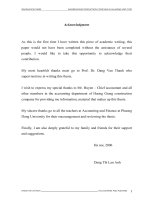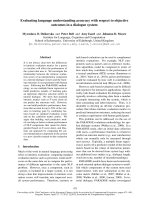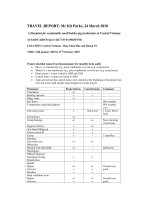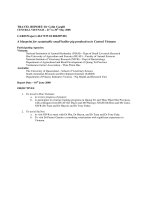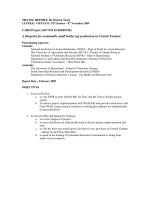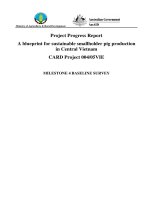EVALUATING HYDROGEN PRODUCTION IN BIOGAS REFORMING IN A MEMBRANE REACTOR
Bạn đang xem bản rút gọn của tài liệu. Xem và tải ngay bản đầy đủ của tài liệu tại đây (446.82 KB, 10 trang )
Brazilian Journal
of Chemical
Engineering
ISSN 0104-6632
Printed in Brazil
www.abeq.org.br/bjche
Vol. 32, No. 01, pp. 201 - 210, January - March, 2015
dx.doi.org/10.1590/0104-6632.20150321s00002820
EVALUATING HYDROGEN PRODUCTION IN
BIOGAS REFORMING IN A MEMBRANE
REACTOR
F. S. A. Silva*, M. Benachour and C. A. M. Abreu
Department of Chemical Engineering, Federal University of Pernambuco,
CEP: 50740-520, Recife - PE, Brazil.
Phone: + (55) (81) 2126-8901
E-mail:
(Submitted: July 1, 2013 ; Revised: February 25, 2014 ; Accepted: April 29, 2014)
Abstract - Syngas and hydrogen production by methane reforming of a biogas (CH4/CO2 = 2.85) using
carbon dioxide was evaluated in a fixed bed reactor with a Pd-Ag membrane in the presence of a nickel
catalyst (Ni 3.31% weight)/γ-Al2O3) at 773 K, 823 K, and 873 K and 1.01×105 Pa. Operation with hydrogen
permeation at 873 K increased the methane conversion to approximately 83% and doubled the hydrogen yield
relative to operation without hydrogen permeation. A mathematical model was formulated to predict the
evolution of the effluent concentrations. Predictions based on the model showed similar evolutions for yields
of hydrogen and carbon monoxide at temperatures below 823 K for operations with and without the hydrogen
permeation. The hydrogen yield reached approximately 21% at 823 K and 47% at 873 K under hydrogen
permeation conditions.
Keywords: Membrane reactor; Biogas; Methane; Syngas; Hydrogen.
INTRODUCTION
The increasing availability of methane has generated substantial interest in alternative methods for its
conversion into synthesis gas (syngas) and/or hydrogen. Research has shown that the catalytic reforming
of methane with carbon dioxide (dry reforming) may
be employed with natural gas and carbon dioxide
emissions rather than traditional methane steam reforming (MSR) for syngas production (Amoro, 1999;
Topalidis, 2007; Abreu et al., 2008; Silva et al.,
2012). Major anthropogenic sources of global carbon
dioxide emissions include flue gases from coal, oilfired power stations, thermoelectric plants, FCC refining units, alcoholic fermentation, and several heavy
industries, such as those that produce iron, lime, and
cement. Biogas, a gaseous mixture of methane and
carbon dioxide, can be directly processed by catalytic
*To whom correspondence should be addressed
reforming (Kolbitsch et al., 2008; Lau et al., 2011).
Biogas is produced from organic household waste,
industrial waste, and animal dung. Landfill gas is the
most important source of biogas because of its relatively high carbon dioxide content (CO2: 36-41%,
CH4: 48-65%, N2: 1-17%, and high methane emissions. Qian et al. (2002) reported a gas generation
rate of 2.50 Nm3/landfill ton/year for old landfills (>
10 years old). Themelis and Ulloa (2007) estimated a
global methane production rate of 75×109 Nm3/year
from 1.5×109 tons/year of solid landfill, of which
only approximately 10% was collected and used.
The expertise developed from the methane dry reforming process (Abreu et al., 2008) can be used to
increase the production of syngas and hydrogen from
biogas. However, thermodynamic constraints and low
catalytic performance have been identified as limitations to achieving high methane conversions into
202
F. S. A. Silva, M. Benachour and C. A. M. Abreu
hydrogen and carbon monoxide. Operational initiatives of selective product permeation (Garcia-Garcia
et al., 2013; Faroldi et al., 2013; Gallucci et al.,
2013) can be used to overcome these restrictions
when the process is in chemical equilibrium by
shifting the composition of the media to increase
reactant conversions.
In general, under the same operating conditions, a
higher reactant conversion is obtained for reactor
operation with permeation using a selective membrane than for a fixed-bed reactor (Kumar et al.,
2008). Membranes of palladium alloys exhibit a high
permeability to hydrogen. Gallucci et al. (2008), Shu
et al. (1991) and Dittmeyer et al. (2001) have written
reviews on palladium membranes that analyze the
effects of permeation on reactor performance.
Kikuchi (1995) demonstrated that the catalytic
activity of various metals that were used in a membrane reactor for reforming processes decreased in
the following order: Ni>Rh>Pt>Pd>Ru>Ir (alumina
support). He used a membrane reactor with a nickel
catalyst in methane reforming with carbon dioxide at
773 K and 1.01 MPa to obtain 47% methane conversion versus the 52% conversion predicted by thermodynamic equilibrium calculations. Thus, the high
activity of nickel and its low cost make it the best
choice for a reforming catalyst, although there is no
evidence that it is susceptible to coke formation
(Pompeo et al., 2007).
This study investigated the activity of a nickel
catalyst to convert a biogas via methane reforming
with carbon dioxide in order to produce synthesis gas
and hydrogen. The process was evaluated in a fixed
bed reactor containing a Pd-Ag membrane selective
to the permeation of hydrogen and in the presence of
the catalyst, in which operations with and without
the permeation of hydrogen through the membrane
were carried out.
EXPERIMENTAL SECTION
Catalyst Preparation and Characterization
The catalyst was prepared using nickel nitrate
(Ni(NO3)2.6H2O, Sigma-Aldrich, Germany) and
gamma-alumina (γ-Al2O3, Degussa, Brazil) via impregnation of alumina with a nickel nitrate solution.
First, the impregnated solution was evaporated to
dryness. The solid was then dried at 393 K for 12 h
and calcinated at 873 K in an argon flow for 5 h.
Finally, the catalyst was activated in a hydrogen
atmosphere at 973 K for 2 h.
The nickel catalyst was characterized by atomic
absorption spectrophotometry (AAS), textural analysis (by the B.E.T. method), and X-ray diffraction
(XRD, using CuK-alpha radiation and a Siemens
D5000 diffractometer).
Experimental Evaluation
The reforming experiments were performed in
a fixed-bed membrane reactor (Figure 1; useful
height, HR = 45.72×10-2 m; outside diameter, DR =
1.07×10-2 m; Pd-Ag, H2 selective membrane, height,
Hm = 0.19 m; inner diameter, dm = 0.32×10-2m; thickness, δm =7.62×10-5 m; REB Research & Consulting,
USA) with a nickel catalyst (<dp> = 412 µm,
mcat = 0.02×10-1 kg) at 773 K, 823 K, and 873 K and
1.01×105 Pa. The reactions were investigated with
and without hydrogen permeation. A pressure reduction was applied to the internal zone of the membrane under permeation conditions to facilitate hydrogen transfer from the external reaction zone
(1.01×105 Pa) to the internal zone (0.20 Pa).
The reactants were fed into the reactor with a biogas
gaseous mixture of CH4:CO2:Ar = 0.89:0.31:1.00 vv at
flow rates ranging from 150 to 400×10-6 m3/min (STP).
(a)
(b)
Figure 1: (a) Scheme of the processing unit of biogas. (A) gas chromatograph, (C1, C2, C3) mass flow meter,
(F) Electrical furnace, (R) membrane reactor, (S1) PC computer-mass flow meter control,(S2) PC computergas chromatograph, (V1, V2) valves, (M1) U manometer, (E1) vacuum pump, (b) Membrane reactor.
Brazilian Journal of Chemical Engineering
Evaluating Hydrogen Production in Biogas Reforming in a Membrane Reactor
At the top of the reactor, three streams of CH4,
CO2 and Ar were fed. The residual reagents and
products were analyzed using on-line gas chromatography (with a Saturn 2000, Varian, Carbosphere/
Porapak-Q, TCD) of the reactor effluent flow.
After having reached a steady-state regime of
processing, the feed stream of methane was stopped
while the flows of argon and carbon dioxide were
maintained. The residual carbon in the reactor was
removed using carbon dioxide via the Boudouard
reverse reaction; the effluent gas was analyzed to
determine the amount of carbon monoxide produced.
Permeation tests were performed using gaseous
mixtures of H2 and Ar (H2:Ar:5:50,10:50, 15:50,
20:50, 25:50 v/v) at 723 K, 773 K, and 823 K. The
results were fitted to the Sieverts equation (JH2 =
JH20.exp(-ED/RT)[(PrH2)1/2- (PpH2)1/2], Rival et al., 2001);
to determine the parameters JH20 and ED. Sieverts
tests were performed after each reaction experiment
to evaluate the state of the membrane.
RESULTS AND DISCUSSION
Catalyst Characterization
The nickel content and the surface areas of the
support (pre-treated Al2O3) and catalyst (Ni/Al2O3)
were 3.31% by weight, 226 m2/g, and 145 m2/g, respectively, as characterized by AAS and B.E.T.-N2.
The solid phases of the catalyst used in the reforming reactions were detected by XRD. The γAl2O3 support was identified at 2θ = 37.4, 45.3, 65.8,
and 66.6, and the nickel metallic phase was identified
at 2θ = 44.1, 52.0, 77.5, and 93.4. Carbon was found in
catalyst samples that were analyzed after the reaction
evaluations. Elementary carbon analysis of the used
catalyst indicated a carbon content ranging from
0.21% to 0.26% in weight.
Hydrogen Permeation Tests
Experiments on permeation through the selective
membrane were conducted in terms of the variables
of the Sieverts equation (Figure 2). The permeation
rate was investigated as a function of the pressure
difference in the membrane at three operating temperatures (723 K, 773 K, and 823 K). The hydrogen
permeation rate increased with the H2/Ar ratio and
temperature. Hydrogen permeation experiments
(Figure 1(b)) were also performed after the reactions
while the system was being cleaned and the catalyst
was being regenerated with carbon dioxide (i.e.,
corresponding to the Boudouard reverse reaction:
CO2 + C → 2CO).
Figure 2(a) presents the fits to the experimental data
using the linear form of the Sieverts equation. These
linear fits were used to estimate the following orders of
magnitude of the parameters: JH20 = (2.21 ± 0.41)×10-5
mol/m2s kPa0.5 and ED = (3.37 ± 0.13)×103 J/mol.
Figure 2(b) presents the results of the hydrogen
permeation tests that were obtained after regeneration of the catalyst in terms of the variables of the
Sieverts equation. For comparison, were also included in this figure the results of the initial tests of
permeation at 823 K.
0.0055
0.004
0.003
0.002
0.001
0.000
0
50
823K
823K (after regeneration)
0.0050
H2 Permeation Rate (mol STP/m2.s)
H2 Permeation rate (mol STP/m2.s)
0.005
723K
773K
823K
100
150
0.5
Membrane pressure difference P
0.5
-P
rH2
200
0.5
(Pa )
pH2
203
0.0045
0.0040
0.0035
0.0030
0.0025
0.0020
0.0015
0.0010
60
80
100
120
140
0.5
Membrane Pressure Difference P
160
0.5
-P
rH2
pH2
180
0.5
(Pa )
(a)
(b)
Figure 2: Permeation rate as a function of the differences between the square roots of pressure in the
membrane: (a) effect of temperature and (b) permeation rate after regeneration at an external reaction
zone pressure of 1.01 × 105 Pa0.5 and an internal zone pressure of 0.20 Pa0.5.
Brazilian Journal of Chemical Engineering Vol. 32, No. 01, pp. 201 - 210, January - March, 2015
204
F. S. A. Silva, M. Benachour and C. A. M. Abreu
Figure 3 presents the carbon dioxide and carbon
monoxide concentrations measured during the cleaning/regeneration operation as a function of the time on
stream.
0.006
CO
CO2
Concentration (mol/L)
0.005
0.004
0.003
0.002
0.001
0.000
0
100
200
300
400
500
time (min)
Figure 3: Carbon removal from the membrane reactor. Catalyst and membrane cleaning/regeneration.
Conditions: mcat= 0.02×10-1 kg, feed molar ratio
Ar/CO2 = 1.0, flow rate = 120 cm3/min, temperature
= 823 K, and pressure = 1.01×105 Pa.
The operational performance of cleaning/ regeneration of the membrane reactor, including carbon
removal from the catalyst and/or membrane, was
determined from the evolution of the reactant and
product concentrations in the Boudouard reverse
reaction (see Figure 3). After 250 min of operation
under a CO2 stream, the CO level was reduced. In
addition, the results of the hydrogen permeation tests
(Figure 2(b)) indicated similar system performance
before and after the reaction.
Process Evaluation
Experimental evaluations of the reforming process of the biogas were performed in the fixed-bed
membrane reactor at three different temperatures
(773 K, 823 K, and 873 K) at 1.01 × 105 Pa for a feed
gas composition of CH4:CO2:Ar = 0.89:0.31:1.00 vv
and a spatial time of τ =1,204.8 kg.s/m3.
The operations were performed in two steps,
without and with hydrogen permeation, followed by
measuring the component concentrations in the reactor effluents. These experimentally determined
concentrations (i.e., the CH4 and CO2 conversions
and the CO, H2, and H2O production) were evaluated
over a 4.5-h period. Figure 4 presents the reactant
conversions (i.e., Xi = [Ci0-Ci]102/Ci0, where i = CH4
and CO2 and where Ci0 denotes the initial concentrations) as a function of the time for operation with and
without hydrogen permeation at the three temperatures shown. Operations at 823 K and 873 K with H2
permeation resulted in higher methane conversions
than operation without H2 permeation under the
same conditions. The same trend was not observed
for the carbon dioxide conversions, which exhibited
only a slight increase at higher-temperature operation. The permeation effect occurred during the reaction step in the methane cracking process, shifting
the reaction equilibrium such that the conversion of
methane to hydrogen was increased. The carbon
dioxide concentrations remained largely unchanged.
with permeation
90
80
CO2 Conversion (%)
162 min
without permeation
(773 K)
(823 K)
(873 K)
75
40
30
144 min
85
(773 K)
(823 K)
(873 K)
144min
50
CH4 Conversion (%)
with permeation
without permeation
95
60
20
144 min
70
65
144min
60
55
50
45
40
35
162 min
30
10
25
0
20
0
50
100
150
200
250
300
350
0
Time on stream(min)
50
100
150
200
250
300
Time on stream (min)
(a)
(b)
Figure 4: Reactant conversions for (a) CH4 and (b) CO2 as a function of time for operations in a
membrane reactor illustrating the effects of temperature under the following conditions: catalyst Ni
(3.31% weight)/γ-Al2O3, mcat = 0.02 × 10-1 kg, feed molar ratio CH4/CO2 = 2.85, and τ = 1,204.8 kg.s/m3
at a pressure of 1.01 × 105 Pa.
Brazilian Journal of Chemical Engineering
Evaluating Hydrogen Production in Biogas Reforming in a Membrane Reactor
Figure 4 illustrates that initiating hydrogen removal by permeation significantly increased the
methane conversion at the two highest temperatures.
In the stages following the permeation step, higher
steady-state methane conversions were attained than
for operation without permeation.
Figure 5 presents the hydrogen and carbon monoxide
yields (Yj = [Cj/ΣCi0] × 102), j = CO and H2) for the
process. The hydrogen production increased for
operation with H2 permeation at 823 K and 873 K,
whereas the carbon monoxide level remained steady.
Tables 1 and 2 provide the experimental conversions and yields obtained under steady-state conditions at the three temperatures considered.
Under hydrogen permeation at 873 K, the methane conversion increased by 83% and the hydrogen
yield was approximately 113% higher compared to
operation without permeation. Galuszka et al. (1998)
obtained a methane conversion of 48.6% and a hydrogen yield of 46.5% using a nickel catalyst in a
205
membrane reactor under the same conditions as this
study.
Although the effects of the operating conditions
(i.e., the feed flow rate, feed ratio, temperature, pressure, and catalyst weight) on the CH4 and CO2 conversions should be considered, the biogas conversion
in a membrane reactor is generally expected to be
greater than that in a fixed-bed reactor.
Munera et al. (2003) evaluated the methane dry
reforming process in a membrane reactor (with a
Pd/Ag membrane) using a 0.6% weight Rh/Al2O3
catalyst at 823 K and atmospheric pressure. The
study obtained methane and carbon dioxide conversions of 33.9% and 41%, respectively, for a feed
molar ratio of CH4/CO2 = 1.0. The methane and carbon dioxide conversions obtained in the present
study were 14.5% and 48%, respectively, under the
same conditions. The lower methane conversion may
be attributed to the applied feed molar ratio
(CH4/CO2 = 2.85) of the biogas.
with permeation
50
144 min
50
(773 K)
(823 K)
(873 K)
40
40
(773 K)
(823 K)
(873 K)
162 min
CO Yield (%)
H2 yield (%)
144 min
30
162mmin
without permeation
30
144 min
20
20
without permeation
144 min
with permeation
10
10
0
50
100
150
200
250
0
300
0
Time on stream(min)
50
100
150
200
250
300
Time on stream(min)
(a)
(b)
Figure 5: Product yield for (a) H2 and (b) CO as a function of time for operation in a membrane reactor
illustrating the effects of temperature under the following conditions: catalyst, Ni (3.31% weight)/γAl2O3, mcat = 0.02 × 10-1 kg, feed molar ratio CH4/CO2 = 2.85, and τ = 1,204.8 kg.s/m3 at a pressure of
1.01 × 105 Pa.
Table 1: Component conversions of the biogas
reforming process in a membrane reactor at the
following steady-state conditions: Ni (3.31%
weight)/γ-Al2O3, mcat = 0.02 × 10-1 kg, feed molar
ratio CH4/CO2 = 2.85, and τ = 1,204.8 kg.s/m3 at a
pressure of 1.01 × 105 Pa.
Temperature
(K)
773
823
873
Conversion (%)
without permeation
CO2
CH4
4.61
35.11
11.53
42.56
19.25
92.61
Conversion (%)
with permeation
CH4
CO2
7.79
34.09
14.54
48.16
35.33
92.87
Table 2: Product yields for the biogas reforming
process in a membrane reactor under the following steady-state conditions: catalyst Ni (3.31%
weight)/γ-Al2O3, mcat = 0.02 × 10-1 kg, feed molar
ratio CH4/CO2 = 2.85, and τ = 1,204.8 kg.s/m3 at a
pressure of 1.01 × 105 Pa.
Temperature
(K)
773
823
873
Yield (%)
Without permeation
CO
H2
7.52
7.14
15.49
30.06
22.80
53.21
Brazilian Journal of Chemical Engineering Vol. 32, No. 01, pp. 201 - 210, January - March, 2015
Yield (%)
with permeation
H2
CO
9.23
15.41
21.14
25.22
47.00
46.82
206
F. S. A. Silva, M. Benachour and C. A. M. Abreu
The experimental results for biogas reforming in
this comparative evaluation were explained using a
set of reaction mechanisms for the reforming process
developed by Abreu et al. (2008) for the same catalyst, which consisted of the following major reaction
steps: methane catalytic cracking, with carbon deposition and hydrogen production (I: CH4 ↔C + 2H2);
hydrogen consumption via a water gas-shift reverse
reaction (II: CO2 + H2↔ CO + H2O); and carbon
consumption by carbon dioxide (III: CO2 + C ↔
2CO, i.e., the Boudouard reverse reaction). Thus, in
operation with hydrogen permeation, the methane
conversion increased to maintain the methane catalytic cracking equilibrium (step I). Accordingly, the
removal of hydrogen from the reaction medium delayed the reverse water gas-shift reaction (step II),
decreasing the carbon dioxide consumption. Therefore, the available carbon dioxide partially cleaned
the carbon deposited on the catalyst (step III), maintaining the activity level of the nickel catalyst during
the process.
conditions employed (biogas mixture diluted in argon, with low content in carbon dioxide, and operations with low methane conversions).
The resulting differential equations were expressed as dCi/dτ + ri= 0, where τ (kg.s/m3) was the
modified spatial time. The differential equation for
the mass balance of hydrogen for the permeation
operation was as follows:
−
dcH2
dτ
− Sm
j0e−ED /RT
p
( CH2 .R.T − PH2
) + rH2 = 0 (6),
where Sm = Am/mcat = (4dm.[(DR2- dm2)ρcat(1-ε)]-1) is the
ratio between the membrane surface area and the mass
of the catalyst and ε denotes the bed porosity. The corresponding initial conditions (τ = τ0) were as follows:
CCH (τ0 ) = CCH ; CCO (τ0 ) = CCO
4
4o
CCO (τ0 ) = C H (τ0 ) = C H
2
Kinetic and Reactor Modeling
The relations rji (j = I, II, III), which correspond
to the rate laws of the reaction steps of the biogas
reforming process, were expressed as follows:
rICH4 =
k1K CH 4 CCH 4
(1)
1 + K CH 4 CCH 4
rIICO2 = k 2 (C H 2 CCO2 −
CCOC H 2O
K eqwgs
)
rIIICO2 = k 3CCO2
(2)
(3)
2
2
O
;
2o
(τ0 ) = 0.
The isothermal conditions of the operations were
guaranteed by the feed, the convective heat discharge, the heat released with hydrogen permeation,
the reaction enthalpies (∆HJ.rJi), and the heat transferred from the oven through the reactor wall. The
thermal behavior of the reactive operations was
modeled by a steady-state energy balance incorporating the aforementioned effects. The following
differential equation (Equation (7)) describes the
temperature evolution as a function of the modified
spatial time:
pM .ρ g
dT
= −(ΔH I rCH4 + ΔH II rCO2 + ΔH III rCO2 )
dτ
4U
(T − TRE )
d R .ρcat
The global reaction rates of each component (ri;
i = CH4, CO2, CO, and H2O) were written as follows:
−
rCH 4 = − rICH 4 ; rCO2 = −(r
S d
− m m (1 − δ H2 )J H2 (H rH2 − H mH2 );
ρ H2 D R
IICO2
+ rIIICO2 )
rCO = rIICO + 2rIIICO2 ;
2
(4)
(7)
T(τ 0 ) = T0
(5)
rH 2 = 2rICH 4 − rIICO2 ; rH 2O = rIICO2
The evolution of the effluent concentrations for
the membrane reactor was obtained from mass balances incorporating component reaction rates based
on the three aforementioned reaction steps. In the
mass balance equation a constant flow rate along the
reactor was considered based on the experimental
where ρg = 15.28 mol/m3, U (the overall heat transfer
coefficient) = 2.41 J/m2.s.K, DR = 1.07× 10-2 m,
ρcat = 1,200 kg/m3, and ρ H2 = 71 kg/m3. The reformer
and sweep gas enthalpy are denoted by HrH2 and HmH2,
respectively. The temperature TRE = T0 = 750 K and
Cp M = 29.30 + 0.023T − 8.96x10−6T 2 − 1.40x10−9T 3
J/mol.K, where CpM denotes the heat capacity of the
mixture of CH4, CO2, and Ar. The enthalpies of re-
Brazilian Journal of Chemical Engineering
Evaluating Hydrogen Production in Biogas Reforming in a Membrane Reactor
T
ΔH J =
∫ ∑ν C
i
PJ dT;C PJ
= a i + bi T + ci T 2 .
To
The mass balance equations and Equation 7 were
solved for the effluent concentrations and the temperature of the reaction medium using the fourthorder Runge-Kutta method. The values of the kinetic
and adsorption parameters were estimated from our
previous work (Abreu et al., 2008). The Arrhenius and
van’t Hoff correlations were expressed as follows:
- methane cracking reaction: k1 = 3.58×109exp
(-248.55/RT) mol/kg.s and KCH4 = 31.39×10-11exp
(167.32/RT) m3/mol;
- water gas-shift reverse reaction: k2 = 1.07×1013exp
(-350.08/RT) (m3)2/mol/kg.s; and
- carbon dioxide-carbon interaction (i.e., the Boudouard reverse reaction): k3 = 1.16×105exp(-115.86/
RT) m3/kg.s.
The equilibrium constant of the water gas-shift
reaction was given as follows:
K eqwgs = exp( − 6.31x10−2 − 1.86x10−7ln(T)
+2.11x10−4T + 9.37x10−4T −1
(8)
−5.44x10−6 (T − 298.15)T −2
The component concentrations at the reactor exit
were calculated as a function of the temperature over
the 750-895 K range for operations with and without
hydrogen permeation under different steady-state
conditions. The experimental results obtained under
model without permeation
model with permeation
experimental results without permeation
experimental results with permeation
13.5
13.0
12.5
CH4 concentration (mol/m3)
12.0
11.5
11.0
10.5
10.0
9.5
9.0
8.5
8.0
7.5
steady-state conditions at 773 K, 823 K, and 873 K
(see Figures 6 and 7) are shown on the same graph
for comparison with the predictions.
Figures 6 and 7 illustrate that the experimental
component concentrations exhibited the same trends
predicted by the model equations, except for hydrogen concentrations at temperatures higher than 823
K (Figure 7(a)). The concentrations of carbon dioxide and carbon monoxide in the output gas were
similar with and without the permeation of hydrogen.
However, the concentrations of methane and hydrogen were approximately 23% and 51% lower, respectively, when the system operated with permeation. Methane was further consumed to maintain the
equilibrium, which was temporarily displaced by
hydrogen permeation. The small amount of available
hydrogen in the reaction medium could be processed
by the water gas shift reverse reaction (step II). Thus,
residual carbon dioxide, not consumed by the reaction with hydrogen, was used to process the carbon
into carbon monoxide by the Boudouard reverse
reaction (step III).
The predicted component concentrations had approximate values at temperatures lower than 823 K
for operations with and without hydrogen permeation. When hydrogen permeation was used, lower
methane, carbon monoxide and hydrogen concentrations were predicted in the reactor effluent gas for
temperatures above 823 K.
Figure 8 presents the model predictions and the
evolution of the carbon monoxide and hydrogen
yields (Yj = [Cj/ ΣCi0] × 102, where j = CO and H2)
with and without hydrogen permeation (CH2 =
CH2permeated + CH2reactor exit). The hydrogen yield was
model with permeation
model without permeation
experimental results without permeation
experimental results with permeation
5
CO2 Concentration (mol/m3)
action can be expressed in the following form:
207
4
3
2
1
0
7.0
6.5
760
780
800
820
840
Temperature (K)
860
880
900
760
780
800
820
840
860
880
900
Temperature (K)
(a)
(b)
Figure 6: Model predictions and experimental concentrations as a function of temperature for steadystate operation with and without hydrogen permeation for methane-carbon dioxide biogas reforming in a
membrane reactor for reactants (a) CH4 and (b) CO2, under the following operating conditions: mcat =
0.02 × 10-1 kg, P = 1.01 × 105Pa, CH4/ CO2 = 2.85, and τ = 1,204.8 kg.s/m3.
Brazilian Journal of Chemical Engineering Vol. 32, No. 01, pp. 201 - 210, January - March, 2015
208
F. S. A. Silva, M. Benachour and C. A. M. Abreu
model without permeation
model with permeation
experimental results without permeation
experimental results with permeation
6
10
CO Concentration (mol/m3)
H2 Concentration (mol/m3)
5
4
3
2
1
0
8
6
4
model without permeation
model with permeation
experimental results without permeation
experimental results with permeation
2
0
-1
760
780
800
820
840
860
880
760
900
780
800
820
840
860
880
900
Temperature (K)
Temperature (K)
(a)
(b)
Figure 7: Model predictions and experimental concentrations as a function of temperature for steadystate operation with and without hydrogen permeation for methane-carbon dioxide biogas reforming in a
membrane reactor, showing products (a) H2 and (b) CO under the following operating conditions: mcat =
0.02 × 10-1 kg, P = 1.01 × 105 Pa, CH4/CO2 = 2.85, and τ = 1,204.8 kg.s/m3.
70
model without permeation
model with permeation
experimental results without permeation
experimental results with permeation
65
60
55
60
50
50
CO Yield (%)
H 2 Yield (%)
45
40
35
30
25
20
40
30
20
15
10
model without permeation
model withpermeation
experimental results without permeation
experimental results withpermeation
10
5
0
0
-5
760
780
800
820
840
860
880
900
760
Temperature (K)
780
800
820
840
860
880
900
Temperature(K)
(a)
(b)
Figure 8: Model predictions and experimental product yields for (a) H2 and (b) CO for operations with
and without hydrogen permeation for methane-carbon dioxide reforming in a membrane reactor under the
following operating conditions: mcat = 0.02 × 10-1 kg, P = 10.1 × 105 Pa, CO2/CH4 = 0.35, and τ = 1,204.8
kg.s/m3.
predicted to increase strongly with the temperature
and more so for operation with permeation. A
higher carbon monoxide yield was predicted for
operation without permeation than with permeation
at 873 K.
An increased sensitivity to thermal effects was
predicted using Sieverts equation for hydrogen mass
transfer by permeation for operation at temperatures
above 840 K. Thus, hydrogen permeation increased
rapidly for operations at temperatures above 840 K,
and the hydrogen production (Figure 8(a)) increased
via methane cracking.
CONCLUSIONS
A fixed-bed reactor with a Pd-Ag/H2 selective
membrane was used to convert biogas into syngas by
a reforming process. The performance of a nickel
catalyst (3.31% weight)/γ-Al2O3) was evaluated at
773 K, 823 K, and 873 K and 1.01 × 105 Pa with and
without hydrogen permeation. Operation with permeation at 873 K increased the biogas methane conversion to approximately 83%, and the hydrogen
yield was 113% higher than that for operation without hydrogen permeation.
Brazilian Journal of Chemical Engineering
Evaluating Hydrogen Production in Biogas Reforming in a Membrane Reactor
A mathematical model was formulated to predict
the evolution of the effluent concentrations of the
membrane reactor as a function of the operating temperature. At temperatures lower than 823 K, similar
evolution profiles were predicted for the hydrogen
and carbon monoxide yields for operations with and
without hydrogen permeation. The hydrogen yield
reached approximately 21% at 823 K and 47% at 873
K under hydrogen permeation conditions.
ACKNOWLEDGMENTS
The authors acknowledge the financial support provided by CAPES, FINEP, and PETROBRAS, Brazil
for this study.
NOTATIONS
A
C
Cp
dm
DR
dp
ED
hm
HR
JH2
JH20
k1
k2
k3
KCH4
Keqwgs
KeqCH4
m
P
rji
R
SBET
T
U
Membrane area
m2
Concentration
mol/m3
Heat capacity
J/mol.K
Inside membrane diameter
m
Outside reactor diameter
m
Catalyst pore diameter
μm
Diffusivity activation energy
J/mol
Membrane height
m
Reactor height
m
Permeation flux
mol/m2.s
Pre-exponential factor for
mol/m2.s.Pa0.5
permeation flux
Kinetic constant for the step
mol/kg.s
I reaction
Kinetic constant for the step (m3)2/mol.kg.s
II reaction
Kinetic constant for the step
m3/kg.s
III reaction
Adsorption equilibrium
m3/mol
constant of methane
Equilibrium constants for
(-)
the RWGS reaction
(-)
Equilibrium constants for
the methane decomposition
reaction
Catalyst mass
kg
Pressure
Pa
Rate of consumption/
mol/kgcat.s
production of component
Gas constant
J/mol.K
Specific surface area
m2/g
Temperature
K
Overall heat transfer
J/s.m2.K
coefficient
X
Y
Conversion
Yield
209
%
%
Greek Letters
ε
ρ
ρg
Bed porosity
Density
Density of gaseous mixture
τ
γ
ΔH
δm
Spatial time
Gamma
Heat of reaction
Thickness
(-)
kg/m3
kg/m3
kg/s.m3
(-)
J/mol
m
Suffix
i
j
rH2
pH2
R
RE
cat
M
Components (CH4, CO2,
CO, H2, and H2O)
Reaction steps
Hydrogen from reaction side
Hydrogen partial pressure
from permeation side
Reactor
Reference
Catalyst
Mixture!
REFERENCES
Abreu, C. A. M., Santos, D. A., Pacífico, J. A., Filho,
N. M. L., Kinetic evaluation of methane-carbon
dioxide reforming process based on the reaction
steps. Ind. Eng. Chem., 47, p. 4617-4622 (2008).
Amoro, J. N., The multiple roles for catalysis in production of H2. Appl. Catal. A: Gen., 176, p. 159176 (1999).
Dittmeyer, R., Volker, H., Daub, K., Membrane reactors for hydrogen and dehydrogenation process
based on supported palladium. J. Mol. Catal. A:
Chem., 173, p. 135-184 (2001).
Faroldi, B., Bosko, M. L., Múnera, J., Lombardo, E.,
Cornaglia, L., Comparison of Ru/La2O2CO3 performance in two different membrane reactors for
hydrogen production. Catal. Today, 213, p. 135144 (2013).
Gallucci, F., Fernandez, E., Corengia, P. and van Sint
Annaland, M., Recent advances on membranes
and membrane reactors for hydrogen production.
Chemical Engineering Science, 92, p. 40-66
(2013).
Gallucci, F., Tosti, S., Basile, A., Pd–Ag tubular
membrane reactors for methane dry reforming: A
reactive method for CO2 consumption and H2
production. Journal of Membrane Science, 317, p.
96-105 (2008).
Brazilian Journal of Chemical Engineering Vol. 32, No. 01, pp. 201 - 210, January - March, 2015
210
F. S. A. Silva, M. Benachour and C. A. M. Abreu
Galuszka, J., Pandey, R. N., Ahmed, S., Methaneconversion to syngas in a palladium membrane
reactor. Catal. Today, 46, p .83-89 (1998).
García-García, F. R., Soria, M. A., Mateos-Pedrero,
C., Guerrero-Ruiz, A., Rodríguez Ramos, I., Li, K.,
Dry reforming of methane using Pd-based membrane reactors fabricated from different substrates. Journal of Membrane Science, 435, p.
218-225 (2013).
Kikuchi, E., Palladium/ceramic membranes for selective hydrogen permeation and their application
to membrane. Catal. Today, 25, p. 333-337 (1995).
Kolbitsch, P., Pfeifer, C., Hofbauer, H., Catalytic steam
reforming of model biogas. Fuel, 87, p. 701-706
(2008).
Kumar, S., Agrawal, M., Kumar, S., Jilani, S., The
production of syngas by dry reforming in membrane reactor using alumina-supported Rh catalyst: A simulation study. J. Chem. React. Eng., 6,
A-109, p. 1-39 (2008).
Lau, C. S., Tsolakis, A., Wyszynski, M. L., Biogas
upgrade to syn-gas (H2–CO) via dry and oxidative reforming. Int. J. Hydrogen Energ., 36, p.
397-404 (2011).
Munera, J., Irusta, S., Cornaglia, L., Lombrado, E.,
CO2 reforming of methane as a source of hydrogen using a membrane reactor. Appl. Catal. A:
Gen., 245, p. 383-395 (2003).
Pompeo, F., Nichio, N. N., Souza, M. M. V. M.,
Cesar, D. V., Ferretti, O. A., Schmal, M., Study of
Ni and Pt catalysts supported on α − Al 2O3 and
ZrO2 applied in methane reforming with CO2.
Appl. Catal. A: Gen., 316, p. 175-183 (2007).
Qian, X., Koerner, R. M., Gray, D. H., Geotechnical
Aspects of Landfill Design and Construction.
First Ed., Prentice Hall, New York (2002).
Rival, O., Grandjean, B. P. A., Guy, C., Sayari, A.,
Larachi, F., Oxygen-free methane aromatization
in a catalytic membrane reactor. Kinet. Catal. React. Eng., 40, p. 2212-2219 (2001).
Shu, J., Grandjean, B. P. A., Van Neste, A., Kaliaguine,
S., Catalytic palladium based membrane reactors:
A review. Can. J. Chem. Eng., 69, p. 1036-1060
(1991).
Silva, F. A., Hori, C. E., da Silva, A. M., Mattos, L.
V., Munera, J., Cornaglia, L., Noronha, F. B.,
Lombardo, N. E., Hydrogen production through
CO2 reforming of CH4 over Pt/CeZrO2/Al2O3
catalysts using a Pd–Ag membrane reactor. Catal.
Today, 193, p. 64-73 (2012).
Themelis, N. J., Ulloa, P. A., Methane generation in
landfills. Renew. Energ., 32, p. 1243-1257 (2007).
Topalidis, A., Petrakis,D. E., Ladavos, A., Loukatzikou,
L., Pomonis,P. J., A kinetic study of methane and
carbon dioxide interconversion over 0.5%Pt/ SrTiO3
catalysts. Catal. Today, 127, p. 238-245 2007).
Brazilian Journal of Chemical Engineering
